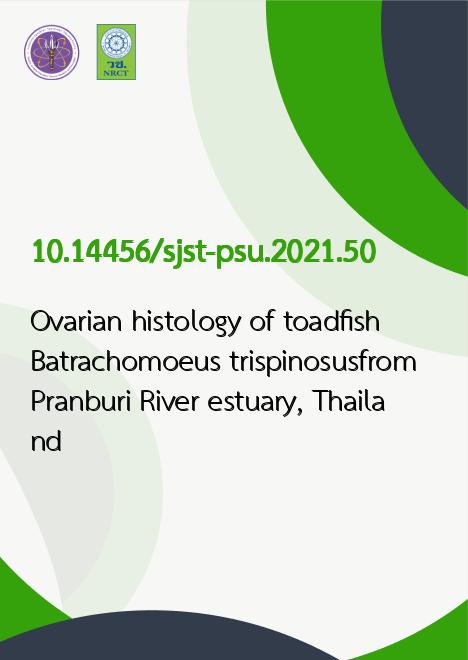
|
Ovarian histology of toadfish Batrachomoeus trispinosusfrom Pranburi River estuary, Thailand |
|---|---|
| รหัสดีโอไอ | |
| Creator | 1. Sinlapachai Senarat 2. Jes Kettratad 3. Piyakorn Boonyoung 4. Wannee Jiraungkoorskul 5. Gen Kaneko 6. Ezra Mongkolchaichana 7. Theerakamol Pengsakul |
| Title | Ovarian histology of toadfish Batrachomoeus trispinosusfrom Pranburi River estuary, Thailand |
| Publisher | Research and Development Office, Prince of Songkla University |
| Publication Year | 2564 |
| Journal Title | Songklanakarin Journal of Science and Technology (SJST) |
| Journal Vol. | 43 |
| Journal No. | 2 |
| Page no. | 384-391 |
| Keyword | Batrachoidae, lipid droplets, microanatomy, ovary, reproduction, Thailand |
| URL Website | https://rdo.psu.ac.th/sjstweb/index.php |
| ISSN | 0125-3395 |
| Abstract | Knowledge of the reproductive biology of the toadfish is still limited. The present study therefore aimed to providebasic knowledge about ovarian histology in the mangrove toadfish Batrachomoeus trispinosus, a potential aquaculture species inThailand. To this end, we performed histological analysis of the ovaries (n = 20, all females, total length 15 to 20 cm) obtainedfrom the Pranburi River estuary, Thailand, during January to April 2017. The ovary of this species was a paired sac-like organlocated in parallel to the digestive tract. We described histological details for the oocytes at following phases: oogonium, primarygrowth phase (further classified into perinucleolar and oil droplets-cortical alveolar steps) and secondary growth phase (earlysecondary growth, late secondary growth, and full-grown oocyte steps). The ovary contained oocytes at different developmentalphases. Most oocytes were in the secondary growth phase (60%), although those in primary growth phase (33.33%) and a fewoogonia (6.66%) were also observed. The primary growth phase was associated with accumulated lipid droplets and corticalalveoli, whereas oocytes at the secondary growth phase contained larger lipid droplets, spherical yolk granules, and associatedchanges of the follicular cell. Overall information from this study provided accurate ovarian features, which will support furtherworks on the reproductive biology of this species. |
